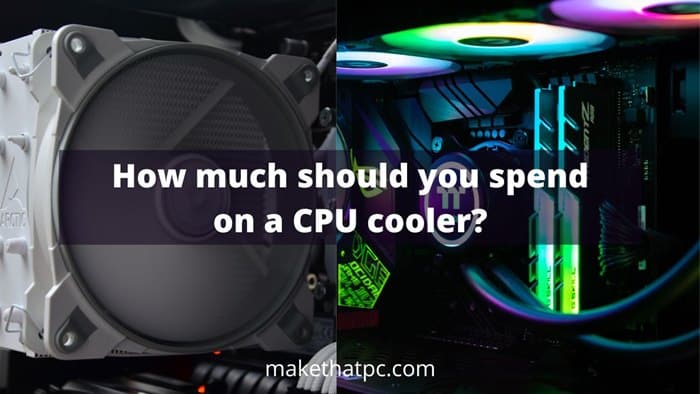It’s a no-brainer that picking a reliable CPU cooler is a crucial decision when building your computer. In case you’re wondering why, a CPU cooler often limits your system overheating, mainly under heavy loads. For starters, the cooler you choose can have a significant impact on your gaming experience. A cooler that can constrain your CPU’s heat output, at times when you overclock is of utmost necessity to avoid throttling, maximizing your system’s potential, and allowing you to experience gaming with no jitters and lags.
You may be confused right now, as the options available in the market are dime a dozen. In that case, feel free to check out my list of recommendations. Do you prefer quiet operation or heavy overclocking? Are you more comfortable with a simple appearance or many RGB lights? Well, there are too many questions in your mind right now, so let me break it down for you bit by bit.
Right off the bat, there are many types of CPU coolers available on the market. With that said, almost all of them fall under three main categories: open-loop, closed-loop, and all-in-one (AIO) aka the custom/open-loop cooling systems.
The AIO coolers are generally expensive but much more effective in cooling and can work with high TDP CPUs. However, the air coolers are good if the TDP is around 100. There are air-coolers with two fans and these can work with much more powerful CPUs.
A good 240mm AIO can cost you around 150$ but some might be available just for around 100$. But, the cheaper ones tend to make a louder noise when running on high RPMs. If we talk about the tower air-coolers, you can easily get a good one just for 50$. It is easy to find affordable CPU coolers these days. But, the expensive and premium ones are generally much quieter.
Open-loop coolers can be the most expensive and complex, offering you not only unsurpassed cooling results but also stunning looks.

How much should I spend on a CPU cooler?
The most critical thing to consider is your budget. Air coolers are generally cheaper than other alternatives, starting at about $25 and even the most expensive (around $100) can be less than comparable AIOs. For the record, an air cooler will usually provide more cooling power per dollar.
By now, you know that AIO coolers are a little more expensive than generic air coolers. They start at $60 and can cost well over $150. Some models in the US may be over 150, depending on their brand, size, and other features. The radiator size and number of RGB LED fans and lights will determine the price of the system.
The most expensive thing about building a custom liquid loop is the cost of its construction. The total cost of a custom liquid loop will be much higher than that of a closed-loop system. So, what will this higher cost mean for you? For starters, you can achieve better performance depending on your system configuration. There are also options to modify the setup with different colors of coolant or tubes and even add cooling to other components like the graphics card. At the end of the day, it’s all up to you.
Custom water loops may not be for everyone.
A custom system has a higher chance of leakage than a closed one, especially if you are not familiar with building cooling loops. However, there is very little chance of a leak if done correctly. Also, this is going to be the most expensive cooling setup if you want to cover GPU and storage along with the CPU.
How can I find out what will work best for my setup?
Whether you intend to pick air, AIOs, or custom water loops is based on a handful of factors. Consider the CPU socket and any chassis restrictions, such as the height of radiator sizes. Most air and closed-loop coolers support AMD and Intel processors/sockets. The most important thing to look at is the TDP of your CPU. Make sure to check the TDP rating of your CPU cooler and the CPU. If they match, you can get that CPU Cooler or AIO.
These devices often include mounting hardware that can be used with multiple sockets. As a result, it increases compatibility with a broad range of sockets. Furthermore, the most popular models usually support Intel 1200 and 115x sockets. Also, support for AMD often includes AM2/AM2+ and AM3/AM3+.
Please note that it is essential to check the specifications of what size heatsink and radiator are supported. The maximum of astonishing height is usually listed by chassis manufacturers, while heatsink makers list the dimensions of their coolers. Air coolers should allow enough clearance for RAM slots. You must also ensure that the cooler has enough support to enable DIMMs with high heat spreaders.
Bottom line
It is easy to get a good AIO for less than 150$. However, if your CPU has a lower TDP, even a cheap tower air-cooler will be more than enough. But, AIOs look good and they can provide much better cooling results. So, you will have to check your requirements and the available budget before going for any cooler. Use platforms like pcpartpicker to make things much easier for you.

I am Anshul Rana, an experienced author specializing in PC gear reviews and Windows 10 software tutorials. With a strong passion for technology and an in-depth understanding of the PC industry, I provide insightful and detailed analyses of computer peripherals, gaming gear, and software solutions. My writing style is concise yet informative, making complex topics accessible to both beginners and advanced users. Through my reviews and tutorials, I aim to offer valuable guidance, helping readers make informed decisions to enhance their PC experience and explore the vast possibilities of Windows 10 software.









